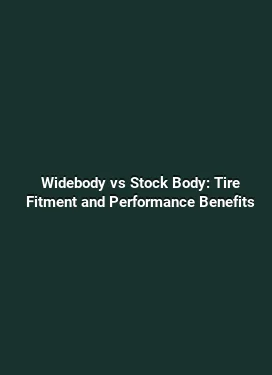Active Aero Systems Guide: Electronic Adjustable Spoilers
Overview of Electronic Adjustable Spoilers in Modern Vehicles

Electronic adjustable spoilers are an integral part of modern active aero systems, engineered to modulate downforce, drag, and overall vehicle stability in real time. Unlike fixed spoilers that offer static performance, electronic variants respond to changing flight- or road-condition inputs, enabling dynamic aerodynamic tuning. The core concept rests on a lightweight actuator system coupled with sensors and a control strategy that translates velocity, acceleration, load, and attitude data into precise spoiler deflection. This capability is especially valuable in high-performance cars and advanced aircraft where aero balance shifts under gusts, braking, or cornering loads.
In practice, electronic adjustable spoilers contribute to a broader ecosystem of active aerodynamics that includes front air dams, vented diffusers, and rear aero surfaces. The ability to rapidly adjust spoiler angle minimizes flow separation and tailplane loading, improving both stability and efficiency. The trend toward electrified actuators and real-time feedback loops has accelerated adoption, reducing mechanical complexity while increasing the granularity of control. For engineers, the challenge lies in harmonizing the spoiler actuation with other aerodynamic surfaces to avoid adverse interactions such as flutter, hysteresis, or unintended lift changes during rapid maneuvers.
Design and Mechanisms: How Electronic Spoilers Operate
The architecture of an electronic adjustable spoiler typically includes three core components: a lightweight actuator, a sensing and control module, and a high-strength spoiler element. Actuators are designed to deliver precise angular deflection with minimal stiction and hysteresis. Modern systems favor compact electric motors or linear actuators that integrate position sensors, load sensors, and thermal monitoring to ensure repeatable performance across operating temperatures and vibration profiles.
The control module processes input from multiple sources: vehicle speed, yaw rate, brake pressure, longitudinal acceleration, and steering angle. This diverse data set enables a robust decision algorithm that determines the optimal spoiler deflection for current conditions. Algorithms commonly employ feedforward and feedback loops, with adaptive tuning to account for wear, component tolerance, and environmental changes. From a reliability standpoint, redundancy in sensors and fail-safe modes are critical to maintaining control integrity in the event of actuator or sensor fault.
Actuation Technologies and Materials

Actuation choices range from brushless DC motors to compact hydraulic strategies, selected based on response speed, power consumption, and packaging constraints. Brushless systems offer fast response and precise control, while hydraulic approaches may be preferred in environments demanding very high force output. The spoiler blade itself is typically constructed from lightweight composites or aluminum alloys, designed to resist fatigue from cyclic deflection and exposure to automotive fluids. Finite element analysis informs rib geometry and mounting strategies to balance stiffness against mass, reducing aerodynamic lag and improving overall system resilience.
Aerodynamic Principles: Why Deflection Matters
Rear spoilers influence the wake structure behind a vehicle, shaping the pressure distribution on the rear fuselage or bumper region. When deployed, the spoiler disrupts the separation bubble that forms on the near-wake side, increasing downforce and, in some configurations, reducing lift-induced drag. The optimal deflection angle depends on vehicle geometry, speed, and center of gravity dynamics. A key aspect is avoiding excessive downforce at low speeds where drag penalties can outweigh handling benefits. Conversely, at high speeds, larger deflection angles can stabilize the tail and suppress lift-induced instabilities without provoking excessive oscillations.
From a flow physics perspective, the spoiler acts as a movable discontinuity in the boundary layer. It alters the pressure gradient, moderates flow separation points, and can influence vortex shedding patterns. Designers must account for aeroelastic coupling—the interaction between aerodynamic forces and structural flexing—to prevent flutter or structural resonances. Computational fluid dynamics (CFD) paired with wind tunnel testing enables iterative refinement of spoiler geometry, hinge line placement, and actuation range to achieve a favorable balance between downforce, drag, and pitch moment control.
LSI and Trend Considerations
Incorporating semantic associations like downforce optimization, drag reduction, boundary layer management, and aeroelastic stability helps ensure that the spoiler design remains relevant across vehicle families and use cases. The trend toward lightweight materials, rapid actuation, and smarter calibration aligns with broader movements in automotive engineering toward efficiency and performance. Designers emphasize low inertia, minimal parasitic losses, and robust performance across temperature extremes, which often shapes material selection and sealing strategies to preserve actuator longevity and protection against dust and moisture ingress.
Integration with Vehicle Systems: Sensing, Control, and Feedback
Electronic adjustable spoilers operate within a networked control environment. The sensing suite typically includes wheel speed sensors, accelerometers, and a yaw-rate sensor, supplemented by longitudinal and lateral acceleration measurements. Some systems incorporate steering torque feedback and ride-height sensors to anticipate load changes and adjust deflection preemptively. The control unit must coordinate with stability control systems, brake-by-wire modules, and, in high-performance platforms, active suspension strategies. Seamless integration reduces the risk of conflicting commands and ensures that spoiler action complements other aero devices rather than competing with them for control authority.
Safe and reliable operation requires attention to fault management. Redundant sensing paths and graceful degradation modes help maintain essential aero control even if a single sensor or actuator fails. Diagnostic routines during startup verify actuator alignment, mechanical clearances, and signal integrity. Thermal management is another critical factor; actuators generate heat during sustained operation, and excessive temperature can degrade accuracy and speed. Consequently, packaging strategies prioritize heat dissipation, shielding, and EMI protection to maintain consistent performance in varied environments.
Performance Metrics and Practical Implications
Evaluating the effectiveness of electronic adjustable spoilers involves a set of performance metrics that span handling, stability, efficiency, and ride quality. Downforce generation is measured as a function of deflection angle and vehicle speed, while induced drag is tracked to assess energy penalties. A well-tuned spoiler enhances cornering grip by increasing rear axle load during aggressive turns, improves high-speed stability by damping pitching motions, and reduces rear-end lift in gusting conditions. The ultimate objective is to achieve a net gain in track or highway performance without compromising daily drivability or fuel economy.
Practical integration requires designers to map spoiler positions to explicit operating envelopes. For instance, a system might deploy a modest deflection at 60 mph to manage tail lift during mid-cornering loads, deepen the deflection at 120 mph for high-speed stability, and retract during low-speed maneuvers to minimize drag. Real-world testing under crosswinds, road irregularities, and transient braking scenarios provides invaluable data to refine control laws. Engineers also consider parasitic power consumption, actuator duty cycles, and predictive maintenance intervals to ensure long-term reliability in diverse climates.
Maintenance, Durability, and Real-World Use
Maintenance strategies focus on keeping linkages clean, ensuring seals remain intact, and verifying sensor calibration. Exposure to road salt, water spray, and temperature fluctuations demands robust corrosion protection and moisture management. Regular diagnostics help detect drift in actuator positioning or anomalies in sensor readings before they affect performance. For fleet operators, cooldown cycles and software updates are essential parts of sustaining predictable behavior across a variety of operating conditions.
Case Studies and Applications: From Sports Cars to Aviation
Sports and performance-oriented vehicles serve as prime showcases for electronic adjustable spoilers. In these platforms, the ability to adapt aero balance on-the-fly translates into tangible gains in lap times, traction control, and high-speed stability. For aircraft-inspired automotive designs, spoilers may integrate with canards and rear wings to produce a cohesive aerodynamic package that remains effective across a wide envelope of speeds and attitudes. In civil aviation, electronically actuated spoilers (or speed brakes) operate in a far different regime, emphasizing rapid deployment and precise retraction in response to flight conditions. Lessons from aerial systems—such as redundancy, fault tolerance, and aerodynamic sensing—often inform automotive implementations, especially in high-performance or mission-critical applications.
Real-world examples illustrate the benefits of well-calibrated systems. A well-tuned electronic spoiler can reduce cornering-induced yaw by smoothing rear-end responses, while a responsive system helps dampen tail lift during crosswinds on highway ramps. In endurance testing, reliability over temperature cycles and vibration profiles emerges as a decisive factor in long-term performance. Designers increasingly benchmark against active aero tools that simulate transient gusts, ensuring the spoiler can adapt to sudden changes without destabilizing the vehicle’s equilibrium.
Future Trends and Considerations
The evolution of electronic adjustable spoilers is closely tied to advancements in actuator technology, materials science, and intelligent control. Emerging trends include the use of lightweight composite vanes with integrated sensors, more sophisticated predictive control algorithms, and seamless integration with electrified powertrains to optimize energy use. As vehicles become more autonomous, spoiler systems will increasingly rely on predictive inputs from navigation, weather data, and vehicle-to-vehicle communication to anticipate aerodynamic needs before maneuvering loads occur. This proactive stance reduces transient drag penalties and improves overall efficiency without compromising safety.
From a design perspective, modular spoiler architectures enable easier maintenance and upgrade paths. Swappable end-caps, standardized mounting interfaces, and plug-and-play actuators can reduce service times and support firmware updates that unlock new aerodynamic strategies. The industry also seeks to minimize actuation noise and vibration, ensuring that the system remains unobtrusive in everyday driving while delivering its performance advantages when demanded by the driver or system demands.
Implementation Guidance for Engineers and Technologists
For engineers considering electronic adjustable spoilers, a structured development path helps align aerodynamic objectives with practical constraints. Begin with a baseline spoiler profile that provides a predictable response to deflection changes, then integrate a modular actuator with calibrated feedback. Incorporate robust sensing and fault-management strategies, ensuring that the control logic accounts for component tolerances and environmental variability. Validate the design in both CFD simulations and wind tunnel environments, followed by real-world validation on test tracks that reproduce representative road conditions, including wet surfaces and gusty crosswinds.
Documentation should capture the decision rationale for actuation range, control gains, and safety margins. Establish maintenance intervals based on duty cycles and temperature exposure, and implement remote diagnostics to monitor actuator health over the vehicle’s life. Finally, cultivate a testing protocol that systematically assesses performance across velocity bands, driving maneuvers, and loading scenarios to ensure consistent behavior across different vehicle configurations and customer requirements.






